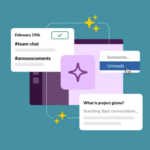
Crunchy or soggy? It’s a straightforward question. However, it’s likely that you’ve never invested much conscious thought into the answer before. It’s simply a part of who you are. When you join Slack’s engineering team, the answer matters. The more discerning among us ask clarifying questions. What percent? What kind? Eventually, though, we all find where we belong.
Me? I’m Team Crunchy. A lifetime member since the uniform was footy pajamas and my cereal of choice was Honey Nut Cheerios.
You need to know these types of things– like how your coworkers prefer their morning cereal and if cilantro fills their mouths with the taste of suds- when you’re collaborating with people on a daily basis. It’s arguable that these tidbits are even more critical when you’re working in a hybrid model, which is probably why these questions are nearly always included during our Ask Me Anything interviews featuring new engineers.
Here are four other things I’ve picked up leading and collaborating with an engineering team in a hybrid/remote model.
1. Create an environment of learning from Day One
Engineers, especially new hires, just want to code, produce, and ship new features– it’s what we do, it’s in our DNA. When an engineer joins a new company, however, they have to catch up on a lot of code and processes. Onboarding new engineers is all about redirecting their energy for the first few months from doing to learning.
Supporting this learning process was easy in the office. At Slack, we would seat you right next to your “onboarding buddy” and it was natural to turn to them and ask them questions. Even with assigned buddies, though, this didn’t translate favorably into the hybrid model. Setting up Zoom meetings required too much activation energy and structured meeting hours felt strained and awkward. One enduring trait of engineers is that they can determinedly set their minds to reading their way to a solution, which doesn’t always benefit them or the team they’re collaborating with.
Slack Huddles is recreating the ease of in-person communication. When a question arises, all an engineer has to do is ping their buddy or another teammate for a few minutes of their time. The other person clicks yes and they’re connected. That’s much closer to what we had before. Of course, this has to be normalized as part of your team culture as well. The easiest way to do that is to model this behavior as a leader, and it’s totally normal for me to start or receive three to four huddle pings a day.
To keep my engineers from crawling up the walls of their home office in their first few months with Slack, they’re still fixing bugs and submitting code. Because not being able to ship code would probably drive them mad. But I remind them, their primary work product during this phase is learning – then shipping.
2. Set high standards, provide feedback that helps people achieve them
Once employees are up to speed, the expectations change from learning to performing. It’s your standards that set your technology apart amongst the millions of apps and feature sets that are released every year. Achieving that auspicious goal requires that every single team member performs to their utmost potential. How do you help your employees get back on track?
Don’t wait until an employee’s performance review to inform them they’re not coming up to scratch. Feedback is somewhat of a perishable good and it’s best when delivered fresh. Building continuous feedback loops into the way you lead and collaborate as a team means consistent improvement is the norm for everyone. Integrating feedback into your day-to-day model also normalizes the process and makes it easier to give and receive.
Be intentional about the way you deliver feedback as well. Focus on framing the feedback around your employee’s role or function and use language that makes it clear this isn’t about who they are as a human being. If it is somewhat personal, reflect how a certain behavior or action may be perceived by others or how it impacts the team.
Follow up by asking for any feedback they have for you as well. Thank them for their honesty, and commit to processing and integrating any valuable feedback you receive– both as a role model and for the benefit of your work.
3. Listen to what’s not being said
Giving, receiving, and integrating feedback are all expedited when your communication skills are sharp. While many people have practiced the art of talking, far fewer have devoted adequate time to listening. My advice to you is to look into active listening. There are nearly as many interpretations of what that means as there are people espousing its positive impact. So while I am listening actively I’ll speak to some specifics.
Listen for what is not being said. Frustrations arise, but some teammates may be reluctant to face conflict head on until the situation gets out of control. It was easy to watch body language, tone of voice, facial expressions, or the way people walk away from a meeting in an office setting. As a leader in a hybrid model, I’ve had to attune my ears and eyes to the minute indicators of how someone communicates via text, audio, and video to keep a pulse on team dynamics. When you’re listening well, you can waylay issues before they mushroom.
Like any good engineer, I appreciate an efficient system. Going remote meant that I needed to tighten up the way that I respond to my team’s professional and interpersonal needs. By systemizing conflict resolution, you guarantee that grievances don’t go unchecked on your to-do lists. These slips can happen due to unconscious bias, a busy schedule, and the blending of our work-home lives. A process makes sure you do it right every time with everyone.
4. Arm your team with the essentials, and get really good at using them
Going hybrid meant a lot of things: being unmoored from an office or an in-person team, the collision of personal and work life, the ability to hire engineers living literally anywhere. It also necessitated a new wa of working together while maintaining the extremely high level of collaboration that engineering teams like mine need.
The tool came first for us, and then came the cultural shift.
We already knew that Slack was a platform for great immediate interaction. It’s asynchronous abilities, however, weren’t as celebrated when we were all in-office at the same time. But once Slack embraced this nebulous work environment– physically and culturally– asynchronous tools began to shine.
A great example is the way we share materials. Now, it’s our norm for California early-birds to log off before their coworkers and drop a file marked “Here’s something to check out.” In the past, people may have felt pressure to immediately respond. Now you know that person isn’t checking comments until early the next morning.
We’ve really changed the expectation so that it’s clear that people are sharing things that are meant to be consumed when their teammates have the space and time to do so- whether that’s in a few minutes, hours, or even weeks in some cases.
Another tool that has been pivotal for our hybrid collaboration is GitHub. We have our own internal controls and compliance that require that every piece of code is reviewed by another engineer. It’s also how better software is made so that there are more engineers, eyes, and minds on it. Code reviews in GitHub have many of the advantages of pair programming – only you don’t have to be sitting next to someone looking at the same code at the same time.
Once you’ve completed your piece of code, you can submit for peer reviews by whomever is available whenever they are. You can also ask someone who has specific subject matter expertise or domain knowledge. It’s the norm that that person will finish what they’re doing and then get to it, it may even be that they ask for a review in kind on their code. This is all asynchronously occurring. In Slack, you know once someone has left comments and you can go back to the feedback when you’re ready.
We’ve really upleveled the way we work together. And, quite frankly, I think if my team was all in the same office, we would still choose to work this way.
Leading in a hybrid model, for me, remains grounded in my values and my skills as a leader. But as an engineer and a leader of engineers, I get excited about the tools we can expand on or create to enhance the way we work together.
We had many of these tools on a rudimentary level pre-pandemic, and through this experience they’ve gotten better. We have also gotten better– our work flows, our norms, our leadership skills, they’re all better. And I’m sure we have farther to go. Looked at on a timeline for scale, if this is how we work forever, we’re not going to figure it all out in the first 18 months. And I, personally, am looking forward to seeing how far we go.






